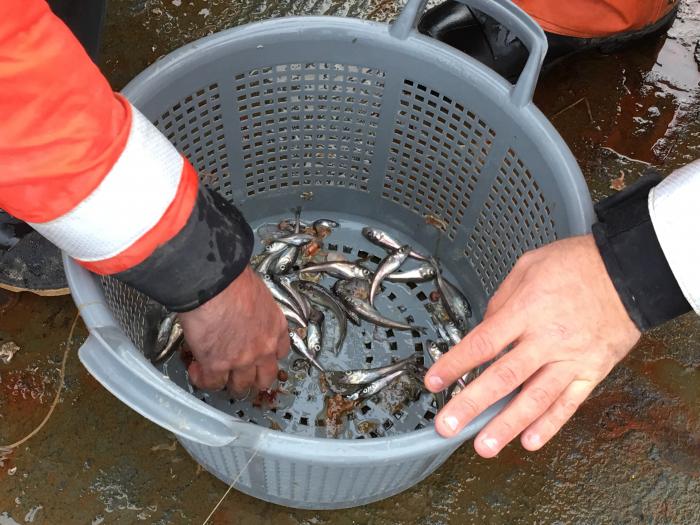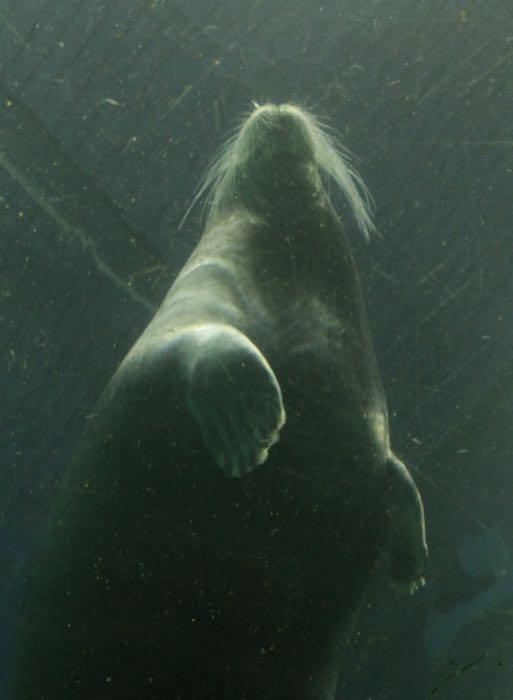Arctic Bites
We watched a mama and cub polar bear today. The bears were very curious, and spent a lot of time investigating the area around the Polarstern. We were able to watch them for almost an hour. It was amazing!
I've been learning more about food webs in this part of the Arctic Ocean. It is actually really complicated, but I'll share some basic information here. There are many organisms that create their own food through photosynthesis. During photosynthesis, living things convert energy from the sun, water, carbon, dioxide and nutrients into sugars and oxygen. Plants are a great example of this. In the Central Arctic Ocean, there are no true plants. But there are plenty of other organisms that photosynthesize here! They form the base of the food web and allow animals both big and small to live here.
There are two broad categories of things that photosynthesize in the Arctic Ocean. First, there are photosynthesizing organisms that live with the sea ice. They can be found in small channels inside the ice as well as attached to the underside of the ice. These are usually called sea ice algae. There are many species of diatoms, dinoflagellates, and flagellates that live in the sea ice. Ice algae are actually only one part of a unique sympagic community. Sympagic refers to organisms that live in the ice. I'll be sharing more about these incredible organisms that live inside sea ice soon! But I need to learn more first.
 Sea ice algae, as seen in the green-brown coloration on this photo, is an important part of the food web in the Arctic Ocean.
Sea ice algae, as seen in the green-brown coloration on this photo, is an important part of the food web in the Arctic Ocean.
The other category of photosynthesizers are phytoplankton in the water column. We've talked a bit about phytoplankton already in my PolarTREC Journals, but these 1-minute videos about diatoms and protists, including dinoflagellates are a good refresher. These categories aren't clear cut -- for example, some species of diatoms are pulled from the water column into the sea ice as it forms. So they are sort of phytoplankton, sort of ice algae.
Whatever you call them, these photosynthesizers are crucial to life in the Arctic. Without them, all of the animals would quickly starve. Small life forms like rotifers, ciliates and bacteria feed on whole or pieces of photosynthesizers. Zooplankton graze on this soup of rotifers, ciliates, bacteria, phytoplankton and ice algae. When the ice begins to melt in summer, a pulse of ice algae is often flushed into the water column. Here, this food is consumed by small shrimp-like crustaceans called copepods and euphausiids (kril) and amphipods. Many of the euphausiids and amphipods are predatory. So instead of eating ice algae or phytoplankton, they eat other euphausiids, amphipods, and copepods. If you use a magnifying glass or microscope to look closely at these small predators, you would see really cool and frightening hooks and claws for grasping and tearing their prey!
 Arctic cod that were caught in the mid-water trawl net. Aboard the R/V Sikuliaq in the Beaufort Sea. Arctic Cod are able to thrive in the dark waters under the sea ice and during the polar night. Photo by Lisa Seff (PolarTREC 2017), Courtesy of ARCUS
Arctic cod that were caught in the mid-water trawl net. Aboard the R/V Sikuliaq in the Beaufort Sea. Arctic Cod are able to thrive in the dark waters under the sea ice and during the polar night. Photo by Lisa Seff (PolarTREC 2017), Courtesy of ARCUS
In turn, these crustaceans are eaten by pelagic fish. Arctic cod Boreogadus saida are considered the key species of fish in the Arctic Ocean. However, not much research has been done in the Central Arctic Ocean, so there is much more to know about Arctic cod and other sea ice linked fish. Arctic cod eat copepods, krill, amphipods, and other fish. One amazing thing about Arctic cod is that they are able to feed in the winter. During this time, the sun never rises, the ocean of the Central Arctic is covered in ice, and light is very limited. And somehow, these fish can still find food!
But they also become food. In particular, they are eaten by a number of seals associated with the sea ice. In the Eurasian Arctic, these are mostly harp seals and ringed seals. There are also bearded seals at the ice edge and some hooded seals. Many seabirds will also eat Arctic cod, especially young cod. Beluga whales will eat Arctic cod too.
 Bearded seals tend to live near the ice edge. I photographed this one at the aquarium in Tromso before we left.
Bearded seals tend to live near the ice edge. I photographed this one at the aquarium in Tromso before we left.
At the top of this food web, we find polar bears. They feed mostly on ice seals but will also feed on beluga whales, narwhals, and even walrus. Humans can share this spot at the top of the food web too. Many people of the Arctic harvest fish and marine mammals like seals, narwhals, and beluga whales for food, and some Indigenous communities harvest polar bears for food as well. But we shouldn't get too confident; a polar bear can also turn humans into food. So this research expedition is taking many precautions to prevent conflict at the top of the food web!
Not all energy moves through the food web on this same track. Some of the phytoplankton, sea ice algae, and bacteria sinks through the water column to the benthos (life at the bottom of the ocean). Here it is taken up by a variety of worms, clams, and crustaceans. Fecal pellets (zooplankton poop) and decaying matter also sink down and are consumed by benthic animals. These clams, worms, and crustaceans are in turn consumed by a number of cool animals. There are many bottom feeding fish, like halibut. Narwhals eat these fish. Walrus specialize in eating clams.
As climate changes, all of these parts of the food web are already and will continue to be affected. The pathways for energy are shifting. We don't know yet whether there is enough biodiversity (different types of life) and resilience (ability to survive changes) in the Arctic to sustain productive food webs and the species that humans depend upon -- for food, for clothing, for economy, and for awe. The ecology team on MOSAiC is hoping to help find some of these answers.
Word of the Day
Ryba is the Russian word for fish -- both in the ocean and on my plate!
Your Questions and Curiosities
How will future economic commerce be impacted by the melting Arctic ice? This is a really crucial and complicated question. There are many ways that economic commerce may be impacted, and most of them are not fully understood yet. As Arctic ice decreases in extent and thickness, new routes through the Arctic will open up for transport of freight. There have already been increases in tourism with specialty Arctic Ocean cruises. New areas for oil and gas exploration on the shallow continental shelves may also be revealed by declining sea ice. And there are lots of questions of how fish species and fisheries may change. There is a likelihood that commercial fisheries may expand along the continental shelves or even into the Central Arctic Ocean. This depends on which species are present, when, and how easy they are to access. It also depends on regulations that will be set. Currently, there is no clear oversight for fisheries in the Central Arctic Ocean but 9 countries and the EU have agreed to forego fishing here for 16 years until more research can be done and policies or regulations can be established.
Education Extension
I am working on some Arctic-specific food web games and activities. In the meantime, Bioaccumulation Tag from CACS is a great, high-energy game based around marine food webs. It is designed to demonstrate how toxins or plastic particles from marine debris can bioaccumulate through the food web, but you can easily adapt it to focus more broadly on transfer of energy.
The Alaska Sea Grant Seas & Watersheds: Ocean and Beach Food Webs unit is a great introduction to marine and coastal food webs. Many of the activities could be adapted to more Arctic species.


Add new comment